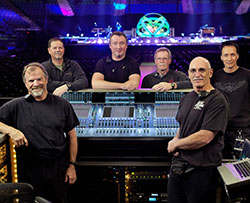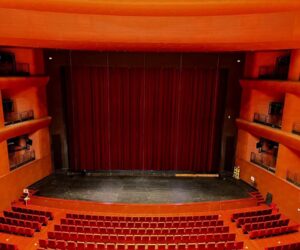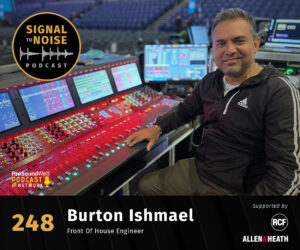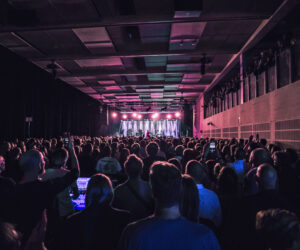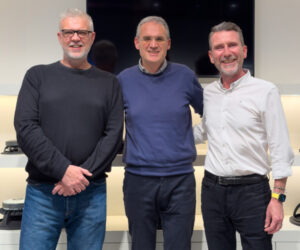After more than a dozen years in retirement, Garth Brooks has returned to the road with his wife, Trisha Yearwood, for a global tour that has already sold over one million tickets. DiGiCo SD7 digital consoles lie at the heart of both the front-of-house and monitor positions.
The trek, in support of Man Against Machine – Brooks’ first new studio album in 13 years – formally kicked off with 10 shows in Chicago on September 4 and is now moving through an ever-growing list of multi-day runs in various cities across North America.
Sonically reinforced by Clair Global, the tour finds Brooks’ longtime FOH engineer, Dan Heins, once again manning the artist’s PA mix, as he has for a quarter of a century. Newer to the team, yet no less experienced, is monitor engineer Troy Milner who joined on after several years at stage right with Bruce Springsteen. But newest of all is a pair of DiGiCo SD7 digital consoles used at both the FOH and monitor mix positions.
This is a camp that can literally have anything it wants, and the decision to go with the SD7 duo was not one made lightly. For Brooks’ big tours in the ‘90s, house and monitors were both on API Paragon desks – hardly standard issue even for a superstar tour. And since then there have been a few smaller outings all on analog. This is the first tour ever for Brooks on a digital console.
The call for the SD7s was driven by a couple of requirements that sound familiar: the sheer number of inputs (124) and outputs (including 16 stereo IEM mixes) needed for a large band doing arenas and stadiums, as well as audio quality and ease of use – a huge consideration for a group used to high-end analog gear.
The selection of the DiGiCo console pair was also attributed to a newer reason, but one that is certainly becoming more important by the day, especially for giant tours like this.
“The ability to put the DiGiRacks and consoles and everything on one fiber loop was huge for us,” says Heins. “We premiered the tour at a stadium in Ireland and the DiGiCo was really the best option to put all of the audio and control, including delays, on a single transport system.”
“I switched to the SD7 a few years ago because I needed more ins and outs, and I haven’t looked back,” Milner chimes in. “Monty Carlo and I moved to the SD7s on Springsteen’s last big tour in 2009 since we had a lot of unknowns about band requirements when we were starting and knew we needed room to grow. I’m glad we made the switch because we added a lot of stuff and it worked out perfectly.”
Heins echoes the thoughts of several other FOH engineers when he notes the ease of use and much-lessened need for channel EQ. “It did not take me long to get very comfortable with the flow of things on the SD7 and now I am just as fast on it. And when it comes to EQ, you plug in a mic, bring it up and you are already close. For example, my kick drum mic has almost no EQ on it at all. With the SD7 there is just no need to really dig into the EQ on any channel.”
In addition to the ins and outs, Milner notes some lesser-known features that he leans on. “There are lots of cool things,” he says. “Macros can do just about anything you dream up. I have them dim all the screens and lights so that, between songs, I can see the band on stage better in the dark. Listen to Copied Audio is an awesome playback feature. Being able to put any input or output or control group on any fader is cool. I also put my talkback mic on one of the master faders so that when I need to talk to one band member in his ears, I just select his mix and my TB is always right there.”
Just like that speed being important to Heins, Milner notes it as well. “I feel like I’m so fast on the SD7 now. When a band member starts to look my direction, I just cue up his mix on faders and I can make any change he asks me for crazy fast. I love that my artists don’t have to wait on me to find things and make adjustments.”
The tour, supported by Clair Global, is a beast that harkens back to the legendary Garth tours of a decade-plus ago. Out front is a massive rig that includes 40 i218M three-way line array elements and an additional 16 i218-LT long-throw elements and 48 i212 medium format line array cabs. Onstage is a veritable a sea of 44 CM22 wedges (the band is on in-ears while the boss is all about the wedges), the volume – both onstage and off – can get “pretty rockin’ but not out of control by any means. That CM22 wedge is a beast and I’m always amazed at what comes out of that box and how great it sounds,” Milner reports. “It’s a game changer.”
And game changing is what this tour, team and artists are all about. From bringing country from clubs and theaters into stadiums to collaborating with rock legends KISS, Brooks has always pushed the boundaries. This tour is going to go on a long time; some reports put it at three years. And instead of moving all the time, the camp arrives in a city and may stay for two weeks and do at least six shows in that time – including two a day on Saturdays.
“It is about balancing supply and demand,” says Heins. “At this point in Garth’s career he does not care if he sells out every show. But he does want to make sure that tickets stay out of the secondary market and remain affordable to his fans. And if adding shows in a city makes that happen, then shows are added.”
When Brooks isn’t touring, Heins stays busy working directly for Clair Global out of Nashville and, as previously noted, has spent a huge part of his career supporting the “best-selling album artist in the United States.” Milner has a unique perspective having mixed monitors for Brooks and Springsteen – two of the biggest and most fan-beloved artists on the planet.
“They are both amazing artists to work with and they both keep me on my toes,” he says. “Both feed off the crowd and it’s all about the connection with their audiences, and neither one of them follow the set list. The big difference would be that one wears a hat and the other one doesn’t. But on this tour, Garth’s vocal is the show, period. But when he plays four notes of a certain song on his guitar the crowds go through the ceiling. It’s pretty amazing.”
And being able to hear those four notes with clarity and definition in every part of venues ranging from large to gigantic is one of the key reasons for choosing DiGiCo.
“It all comes down to sound,” sums Heins. And after having his choice of the best-of-the-best for the better part of three decades, he could have chosen anything. “When it comes to digital, the DiGiCo just sounds great.”


